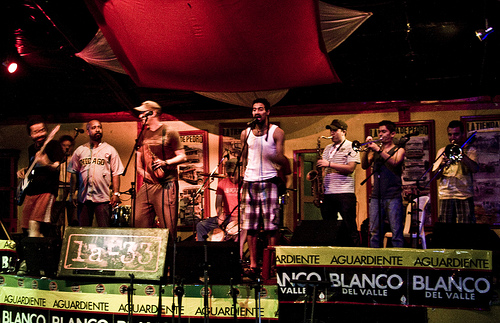Like hip-hop, salsa music emerged from New York City during the mid-to-late 1970s. However, the genre was actually popular for 30 years prior to that, just without the term salsa being applied to it. The Cuban community in the city, particularly Afro-Cubans, were mainly responsible for its popularity, with mambo bands playing regularly at venues across the city in the 1940s and 1950s.

At this time, there were strong links between the musical communities of the United States and Cuba, but the partial and then near total US embargo against Cuba, in 1960 and 1962 respectively, severed these links and prevented the evolution of music in Cuba from reaching and influencing the mainland.
Salsa in the 70s
The 70s was when the term salsa was first used, and when the style became popular across the Americas. From New York, salsa travelled quickly along the east and south coasts, before catching on in Mexico, the northernmost South American countries, and several of the Caribbean islands.
Innovation in salsa was popular throughout the 70s; Willie Colón, for example, introduced new instruments from Puerto Rico and experimented with both rock and jazz styles in his music, while native sounds from Panama and Brazil would also feature prominently.
Celia Cruz was already a massive star in Cuba and achieved the same status in the US, becoming known as ‘The Queen of Salsa’ and becoming a leading player not just in salsa, but also on the fast evolving general music scene.
The 1980s: When Salsa Goes Global
Having become popular throughout the Americas in the 70s, the 1980s saw salsa migrate to Europe, Africa, and Japan, as well as the southernmost Latin American nations. As a result, salsa started to become more diversified as various influences took hold and the genre was interpreted and developed in a variety of ways.
African and Cuban salsa would develop unique styles and become genres all on their own, although Cuban music was already popular in Africa from the mid-20th century onwards. Elsewhere around the world, other genres to be evolving at the time, including hip-hop, R&B, and soul, would start to influence salsa as well as borrow ideas from this genre, creating blurred lines between these styles that can still be seen in some artists work today.
1990s Salsa to Today
During the late 80s, the meteoric rise of hip-hop prevented salsa from becoming a mainstream genre. In fact, salsa artists struggled for any type of publicity or success at this time, even in the Americas where it remained widely appreciated.
This changed in the mid-90s, however, when acclaimed producer and pianist Sergio George moved away from an exclusive salsa approach and began to mix salsa with popular music to create successful commercial tracks. Many of George’s ideas were seen as controversial and being ‘disloyal’ to the tradition of salsa, although many recognised them as necessary steps to raise awareness of the genre and make salsa appreciated globally once more.
Today, salsa continues to evolve, with ‘Latin house’ music being popular in Central and South America, while the leading salsa artists continue to enjoy some mainstream success across the Americas.
Image Source: klem@s
Are you a guitarist? Check out our full range of online guitar lessonsAre you a saxophonist? Check out our full range of online saxophone lessons
Subscribe to Pro Music Tutor from as little as £7.99 per month
Related Posts
-
Is Music Theory Important to Modern Musicians?
The importance of music theory is a hot debate topic in the world of professional music. Some believe knowledge of music theory is what makes you a true musician, whereas some feel their lack of music theory knowledge is like a badge of honour. With the eternal debate over the importance of music theory raging […]
View All >> -
5 Ways Spanish Music Influenced the World
Contemporary popular music has transcended all national boundaries, with different types of music being performed and listened to in all corners of the world. Each culture also adds their own little tweaks and twists to the music, constantly creating new sounds and influences. Spanish music has deeply influenced the popular music we listen to today. […]
View All >>
Latest Blog Entries
-
The Benefits of Online Music Education
Learning music has never been easier, since the internet and modern technological advancements have opened the doors to countless possibilities, expanding the subjects people can choose from and how the lessons are taught. Now, people can study a whole host of music-related topics; from learning to play guitar or DJing, to understanding the inner workings […]
View All >> -
Essential Jazz Guitar Scales that are Easy to Learn
Improvising in jazz requires the ability to play in different keys over different chords. Results certainly do not come overnight, but with diligent practice, you would be surprised by what you can achieve. Many people ask me about what scales I use as if they were some big secret. While knowing your scales is very […]
View All >>
Blog Categories
- Categories
- Guitar Tips (93)
- History (36)
- How-To (38)
- Interviews (3)
- Music Industry (121)
- Prolinks Guitar (2)
- Prolinks Lessons (3)
- Prolinks Tutor's Profile (1)
- Saxophone Tips (40)
- Uncategorized (6)
Tags
Archive
- November 2018 (1)
- February 2018 (1)
- December 2017 (1)
- November 2017 (1)
- October 2017 (1)
- July 2017 (4)
- May 2017 (2)
- April 2017 (1)
- August 2016 (2)
- July 2016 (1)
- June 2016 (2)
- May 2016 (3)

